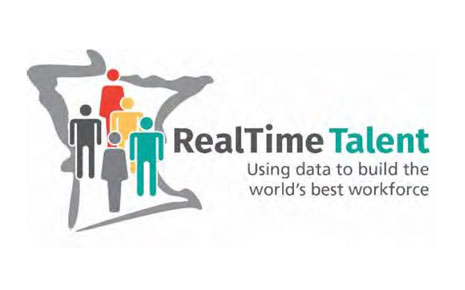Ramsey County Workforce Solutions: Green Construction

Introduction
The digital transformation is happening in Construction, and it intersects with the greening of the industry. Nationally and locally, the Construction Industry experienced tumultuous impacts of the COVID-19 pandemic and corresponding global economic slowdown, including project delays, materials shortage, and layoffs. Technology is not new to the Construction Industry; however, with a reduced headcount and tight profit margins, the adoption of new technology tools accelerated during the pandemic. Advances in technology make Green Construction sustainable by making construction generally more energy-efficient, cost-effective, and safer.
The greening of the industry and technological advancements have differentially impacted and, in some cases, redefined Construction occupations. As technology innovations are integrated into construction project management tools and construction tasks, technology-based skills become a part of construction occupations. John O’Phelan from Ramsey County Workforce Solutions stresses the imperative of “developing, retraining, and retaining the workforce to support the future skills that match technological trends” and adds that Construction talent “need[s] continuous lifelong training in crafts and tech coding to extend their value and earning potential.” [1]
Defining Green Construction
This report focuses on roles identified as "Green Occupations" by O*NET that also have 50 percent or more share of the Construction Industry (NAICS) total occupational employment in Ramsey County. Workforce implications to existing Construction roles in these sectors of the Green Economy revolve around energy reduction, green retrofitting, use of green building materials, inspecting greener building materials, and reducing energy costs in all stages of the constructions process.
As of the fourth quarter of 2020, an estimated 7,087 people work in Ramsey County in Green Construction roles such as Heating, Air Conditioning, and Refrigeration Mechanics and Installers, Cement Masons and Concrete Finishers, and Solar Photovoltaic Installers, representing about 2% of all local employment. Like the overall Construction roles, Green Construction occupations have relatively high unemployment, estimated at 7.6% as of the fourth quarter of 2020, potentially due to the pandemic's impacts. The local average annual wage in Green Construction careers is about $72,700 compared to $62,100 across all Ramsey County employment.
Analysis
Shrinking Workforce
Due to the nature of the work, the Construction Industry faces limitations to talent entering and exiting roles early. Compared to overall employment in Ramsey County, Green Construction careers have a lower share of youth ages 16 to 19 and adults ages 55 and older. Minnesota’s Child Labor Law prohibits youth under 18 years old from working in any “particularly hazardous” occupation, including many construction roles.[2] Regarding aging Construction workers, per the Center for Construction Research and Training, non-union construction workers tend to stop working in Construction at an earlier age than other fields, which may be due to the job's physical demands.[3]
Lack of diversity employment
Women and diverse talent are underrepresented in Ramsey County’s Green Construction careers. Women make up 49.8% of workers in all occupations across Ramsey County, but they hold 3.8% of local Green Construction roles. In contrast, male talent assumes the majority of Green Construction positions, representing about 96.2% of the workers in these occupations – about 46 percentage points higher than the frequency seen in all occupations in the County. Across the Green Construction occupations in Ramsey County, there are higher numbers of White workers (81% compared to 73% overall) and Hispanic (16% compared to 7% overall) than expected by their local employment rate. Locally, many community-based training programs seek to prepare people from underrepresented communities for entry and success in the building trades.
Hiring Challenges
Beyond pandemic-related issues, the top challenge for construction employers was recruiting and training skilled workers, according to AGC Minnesota Construction Industry Assessment, 2020-2021.
With all the local construction training programs, the AGC’s survey of union and non-union gives us insight into where statewide employers are using as current hiring sources. Among union employers responding to AGC’s assessment, when asked what percentage of their hiring was done through different workforce pools, 69% stated they do not use technical colleges, and 68% do not use community training programs to hire workers.[4] Among non-union contractors responding to the same assessment, 85% do not use technical colleges, and 92% do not use community training programs to hire workers.[5] While JATC trained workers continue to be a strong labor source, the hiring source used most (over 75%) by union and non-union contractors was "Other." In addition to Technical Colleges and Community Training Programs not being a labor source, employer perceptions are low regarding Construction programming scope. With an already tight labor market, it will take a coordinated effort to recruit and train skilled Construction workers. Below are potential strategies to expand the workforce pool by increasing equitable access to Green Construction careers.
Recommendations
Employer Engagement and Partnerships
- Align programming through employer engagement: Engaging local employers with technical colleges and community training programs could increase alignment of the academic, technical, and employability skills trainees need for entry and success in any trade could be essential to expanding the construction trades’ hiring pool.
- Enhance Employer Diversity Initiatives through Partnerships: Among employers responding to the AGC Minnesota Construction Industry Assessment, 2020-2021, 69% stated they were taking deliberate measures to attract and retain people of color and women, and 54% said those measures were working. [6]
Expand wraparound services for youth, apprenticeship, and community-based programs in Ramsey County to address barriers, attract and retain people of color and women.
- Assist with Driver’s Licensing: Five out of eight locally identified community-based training programs and eight out of eleven of the Registered Apprenticeships in the County require a Minnesota Driver’s license. Disproportionately, people with low income, people of color, and new immigrants lack a Driver’s License.[7] Pre-apprenticeships could provide construction training and education and assist with driver's licensing and transportation like those in the Seattle Metro area.[8]
- Expand Childcare Assistance: As of the fourth quarter of 2020, women hold 3.8% of local Green Construction roles, despite making up 49.8% of workers in all occupations across Ramsey County. According to Minnesota Building Trades, about 6% or 615 of union construction apprentices in Minnesota are women.[9] Many of the local apprenticeships have schedules that make childcare complicated by requiring early travel to a work site as well as evening classes. Female apprentices report that affordable childcare is a barrier to participating in apprenticeship programs, per The Impact of Construction Apprenticeship Programs in Minnesota report. [10]
Build inclusive and meaningful pathways for career advancement in areas of growth
- Build out pathways in high growth areas of Green Constructions: In Ramsey County, the largest expansion in Green Construction employment over the next five years is for Solar Photovoltaic Installers (4.5% annual growth) as of the fourth quarter of 2020. Construction Manager roles are estimated to have the second-largest expansion (1.0% annual growth) in the County during the same period.
- Design inclusive and meaningful pathways for career advancement at every stage:
- Attract and train diverse talent early: Invest in technology training in current youth Construction training programs that seek to increase youth participation from underrepresented communities while creating a pipeline to get young people into Construction careers.
- Retain by promoting inclusive workplaces and training environments: Apprentice registration in Construction trades is growing in diversity, but the persistent employment disparities in these roles across multiple sectors are troubling. Apprentice completion data disaggregated by race, ethnicity, and gender would be a valuable tool for further research into retaining apprentices and informing apprentice programs’ recruitment, persistence, and retention strategies.
- Ensure portability of credentials to support career advancement: Building a pipeline from production positions into non-production positions, like Construction Managers, could also help retain skilled talent. Most management roles within Construction require bachelor’s degrees, and 14.0% of Construction workers have a four-year degree compared to 31.7% seen in all occupations in the County. College credit earned from completing a Construction apprenticeship program could support transitioning talent into a supervisory or management role within their crafts, like Construction Managers, or in a related field.
[1] John O’Phelan, Reinventing Our Construction Workforce Through Technology Advancements, December 2017.
[2] Department of Labor and Industry, Ensuring the safety of youth in skilled trades training programs, Report to the Minnesota Legislature, 2020, http://www.dli.mn.gov/sites/default/files/pdf/YouthInSkilledTradesStudy_011520.pdf
[3] https://www.cpwr.com/research/data-center/the-construction-chart-book/chart-book-6th-edition-labor-force-characteristics-age-of-construction-workers-by-union-status-hispanic-ethnicity-type-of-employment-and-occupation/
[4] Associated General Contractors of Minnesota, Minnesota Construction Industry Assessment, 2020 – 2021, https://agcmn-c5.s3.us-east-2.amazonaws.com/6116/0706/2722/2020_AGC_Minnesota_Construction_Industry_Assessment-web.pdf
[5] Associated General Contractors of Minnesota, Minnesota Construction Industry Assessment, 2020 – 2021, https://agcmn-c5.s3.us-east-2.amazonaws.com/6116/0706/2722/2020_AGC_Minnesota_Construction_Industry_Assessment-web.pdf
[6] Associated General Contractors of Minnesota, Minnesota Construction Industry Assessment, 2020 – 2021, https://agcmn-c5.s3.us-east-2.amazonaws.com/6116/0706/2722/2020_AGC_Minnesota_Construction_Industry_Assessment-web.pdf
[7] http://www.mnlegalservices.org/legal-services-in-the-news/2021/3/11/minnesota-asset-building-coalition-advocates-to-end-license-suspension-treadmill & https://www.house.leg.state.mn.us/SessionDaily/Story/15690
[8]http://www.seattle.gov/documents/Departments/FAS/PurchasingAndContracting/Labor/ApprenticeshipGuidebook.pdf#page=11&zoom=100,0,0
[9] https://mntrades.org/apprenticeship/
[10] https://faircontracting.org/wp-content/uploads/2019/09/mepi-uiuc-impact-of-apprenticeships-programs-in-minnesota.pdf
Posted: July 29, 2021
Category:







